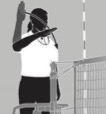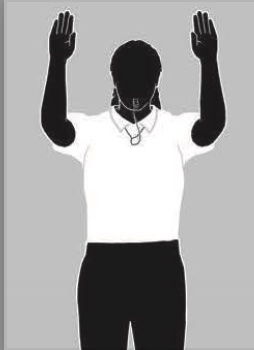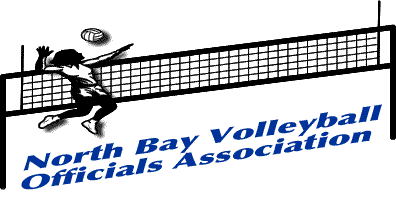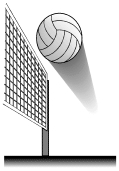|
Back Row Players
| Introduction |
With six players on each side moving around during play the status of a player can be easily lost. The following will help the First Referee (R1) pick up back row players.
Videos on Back Row Players:
Updated: September 2023
|
| Back Row Attacks

|
It is a back row attack when a back row player takes off from on or in front of the attack line, then:
- Attacks and/or directs a ball which is completely above the height of the net,
- AND the ball:
- Has passed beyond the vertical plane of the net,
- Is partially over the net and is contacted by an opponent, or
- No part of the ball has crossed the net, and it is legally blocked.
Intent was removed in 2007.
If a back row player:
- Sets the ball completely above the height of the net on/in front of the attack line and
- The ball the enters the plane of the net
- AND the receiving team contacts the ball,
it is an illegal back row attack.
|
 |
It is NOT a back row attack when a back row player:
- Takes off from behind the attack line, contacts the ball entirely above the top of the net and the ball crosses the plane of the net.
- Exception: The Libero cannot attack a ball that is completely above the top of the net from anywhere on the court and the ball crosses the net or is blocked.
- Takes off from any point on the court, contacts the ball and the bottom of the ball is below the top of the net, and the ball crosses the plane of the net.
|
 |
+If you are not sure if the player making the contact is a back row player the call can be delayed until you identify their position as being in the back row or front row.
|
| Back Row Attack Usual Suspects |
There are two types of players that usually make back row attacks, either legal or illegal, setters and hitters:
Setters:
- The setter(s): A team may run one setter for the entire game that will make it easy for the First Referee (R1) to trackcng them all the time.
- They may also use two setters in that case they are usually opposite of each other at the time of serve.
- When a team uses two setters you will have to know the position of the “active” setter at the time of serve. The “active” setter may be in the front row, but they usually come from the back row.
When will a back row attack by a setter usually occur:
- On over passes to the setter who's at the net trying to save the ball from going over.
- If they are able to save it from going over, while the ball is in the plane of the net, without oppoent touching - all is good - no violation.
- If the opponent's block or touch the ball after the back row setter touches while the ball is in the plane of the net it is a back row attack.
- If the opponent's block the ball back into the back row setter's hands, which are above the net, then it is a back row block.
Back Row Hitters:
- A team will have one or two hitters that will make most, if not all, the spikes.
- A hitter maybe a back row player (not the libero) and thus must take off from behind the attack line.
|
| Identifying Them |
Prior to calling for serve the First Referee (R1) will scan the court:
- Start with the receiving team and make a mental note of the position of the usual suspects for that team in regards to them either being in the front row or back row.
- Then check your Second Referee (R2) and see if they are ready.
- The scan the serving team and make a mental note of the position of their suspects.
Another technique besides "mental" noting is to do a physical one:
- Wiggle the pinky finger on the hand on that side if that usual suspect, setter, is in the back row.
- Wiggle the thumb on the hand on that side if that usual suspect, setter, is in the front row.
During play you will normally see how a team develops their offensive and whom they go to for the “kill”. When s a player is going to hit the ball you will say to yourself “back row” or “front row”.
On all legal back row attacks give the “legal back row attack” signal. This will let coaches and players know that you know it was a back row player attacking the ball but it was legal.
It’s during the long rallies that we have a tendency to forget the position of players. When a questionable player attacks the ball make a mental note of the number or face. As you go with the ball to the other team’s side use your peripheral vision to see where that player goes.
- Back row players normally retreat to the back row in order to play defense.
- Front row players go to or stay at the net to “block”.
- On dead balls see what position the player goes to prior to the serve. If a team rotates into position because of receiving the point and serve, you’ll have to figure out what the player’s position was. Example: The LB rotates into the LF position. If the LB was the player that attacked the ball in front of the attack line with the ball above the top of the net – you have a “back row attack.”
When a team uses only one setter, the setter sometimes forgets if they were in the front row or back. Pay attention to this, as the setter could “dump” a ball or go up to block, forgetting their position as a back row player at that time.
+Back row attacks and back row blocks do not have to be called immediately. However, they do have to be called prior to the next serve being contacted.
|
| Back Row Blocks

|
"Blocking" is the action of a player(s) close to the net that deflects the ball coming from the opponent by reaching higher than the top of the net. A block may involve wrist action provided there is no prolonged contact.
Back row players, except the Libero, may participate in a collective block as long as there is no contact with the ball by any of the players of the collective block.
If a back row player at the net, along with the blockers, attempts to block and is touched by the ball or the ball touches any of the players in that collective block, it is a back row block violation.
+If you are not sure if the player making the contact is a back row player, the call can be delayed until you identify their position as being in the back row or front row.
|
| Back Row Block Usual Suspects |
Back Row setter's usually attempt back row blocks. This doesn't mean other back row players won't attempt a back row block, but they usually are away from the net to save any ball coming over net the back of their court. Libero's can NEVER attempt to block even if the ball doesn't touch them.
- A team may run one setter for the entire game that will make it easy for the R1 to identfy them up all the time.
- They may also use two setters in that case they are usually opposite of each other at the time of serve.
Back row blocks usually occur when there is an over pass to the setter at the net who is a back row player.
- The setter will turn with the ball as it passes over the net with the hand(s) high above the head; or
- Attempt to bring an over pass to them back, miss the ball, and the opponent's hit the ball into the back row setter's hands above the top of the net.
|
Top
|





